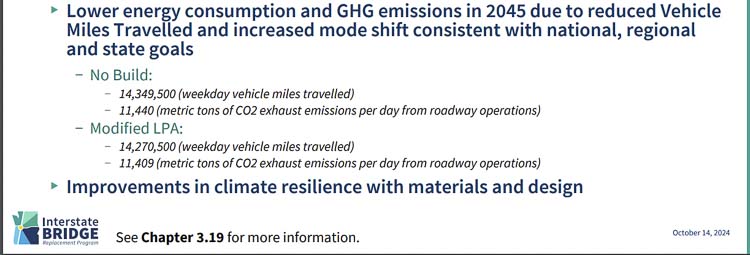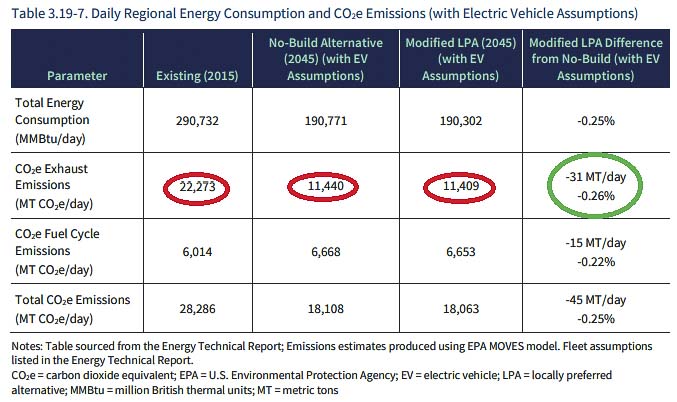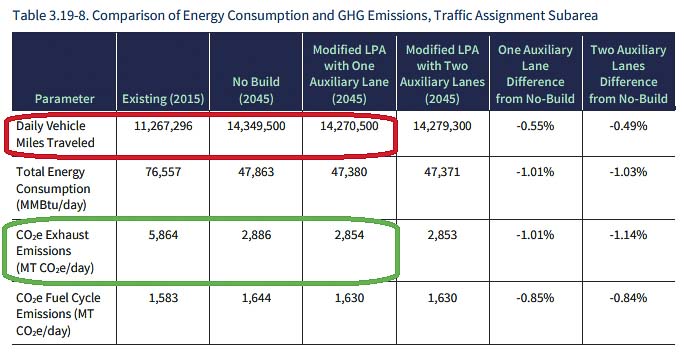It will take over 41 years to offset the construction GreenHouse Gas emissions
John Ley
For Clark County Today
At the Oct. 14 meeting of the 16 member Bi-state Bridge Committee of Washington and Oregon legislators, Sen. Lynda Wilson hit upon a key piece of the multifaceted Interstate Bridge Replacement Program (IBR). The Locally Preferred Alternative (LPA) is alleged to be “green” in part because it reduces CO2 emissions. But how much?
One part of the “green” claim is that Program Administrator Greg Johnson and his team have chosen to allocate 54 percent of the $7.5 billion bridge surface area to bikes, pedestrians and transit. Only 46 percent of the surface is allocated to cars and trucks. The plan is to replace a three lane bridge with another three-through lane bridge, plus a single auxiliary lane for traffic merging on and off the tolled bridge.
If there were fewer cars and trucks on the replacement bridge it would make for less vehicle emissions. But the program admits there will be a 26 percent increase in the number of vehicles using the bridge in 2045. Travel times, especially in the morning southbound commute, will be much worse. An idling car emits about 20 times more pollution than a car traveling at 30 miles per hour, according to the EPA.
Both Washington and Oregon have legal requirements that all new cars sold in 2035 will be zero emission or hybrid vehicles. In December 2021, the Biden Administration issued an Executive Order calling for most federal vehicle acquisitions to be zero-emission vehicles by 2035.

In 2045, the program expects 175,000 vehicles on the I-5 Interstate Bridge if the LPA is built. That’s just 5,000 vehicles below the 180,000 projected if nothing were done. Today they report 143,000 vehicles. But a decade after the zero emission vehicle mandates, one would expect very few would be non-zero emission vehicles.
The 9 to 15 years of construction of the LPA will create 469,444 metric tons of CO2, according to the Draft Environmental Impact Statement (DSEIS). Doing nothing would be “cleaner” from a Greenhouse Gas (GHG) emissions perspective.
Sen. Wilson noted a briefing slide indicating a carbon emission “savings” of just 31 metric tons of CO2 per day. “You’re looking at 31 metric tons of CO2,” she said. She noted she can buy an airplane ticket and buy a carbon offset. She was shocked at the result – “31 metric tons is very, very little; so for $7.5 billion dollars?”
This was comparing the “No Build” alternative and the LPA in 2045. In 2015, there were 22,273 metric tons (MT) of carbon emissions. Doing nothing shows a reduction to 11,440 MT. The LPA shows 11,409 MT. Not building the LPA delivers a 49 percent reduction in carbon emissions while also saving $7.5 billion.
Additionally, total Vehicle Miles Traveled (VMT) was just 79,000 less, or a 0.55 percent reduction compared to the No Build option. There will be a 3-million mile increase in daily VMT by 2045.
Johnson responded to Sen. Wilson’s statement by noting the change to zero emission fleets, plus the IBR projects a 26 percent increase in the number of vehicles on the road.
Presently, the cost of a ton of carbon in Washington state is $29.88 (September). It has varied since the Climate Commitment Act began, with a high of $63. If one used an average of $40 per ton, it would cost just $1,240 per day or less than a penny per vehicle to buy carbon offsets for the Interstate Bridge.
The project is projecting vehicle travel times for the morning, southbound commute will increase significantly from about 29 minutes today, to 54 minutes in the LPA and 58 minutes in the No Build alternative. If they added a second auxiliary lane, travel times would drop to 50 minutes in the morning. Yet Johnson still maintains “you can’t build your way out of traffic congestion,” in spite of the two auxiliary lane option saving people 8 minutes in morning travel time.

Chris Smith of the Just Crossing Alliance noted another huge disparity in the IBR data. “One of the surprising results in the IBR Draft Supplemental EIS is that the express buses running from downtown Vancouver to downtown Portland get SLOWER in the morning in the 2045 horizon year,” he said in a written statement. “In the no-build scenario these buses take 48 minutes. In the build scenario (aka Modified Locally Preferred Alternative) they take 59 minutes.”
This added 11 minutes of travel time for C-TRAN express buses, again raises the question of how effective the design is. It certainly questions the “green” nature of the proposal when doing nothing would save time and presumably carbon emissions of transit vehicles not stuck in stop and go traffic.
“The IBR Program aims to accelerate the local reduction of GHG emissions by developing alternatives to driving, managing transportation demand, and minimizing emissions associated with construction,” the DSEIS says. They note by 2050, ‘Washington state has a target reduction of 95 percent below 1990 levels.” Oregon has similar target levels for reducing CO2 emissions.
Clearly this program fails to advance each state’s climate goals when the project admits to a reduction of just 0.27 percent of CO2 compared to the No Build alternative. Furthermore, the construction of the replacement bridge(s) will emit 469,444 metric tons of CO2. It will take over 41 years to recover just the construction GHG emissions, with a project that saves only 31 metric tons per day.
The DSEIS states “Portland’s Transportation System Plan aims to implement projects that shift travel behavior to increase trips to active and low-carbon modes of travel and projects that reduce vehicle miles traveled to meet emissions-reduction targets.” But after spending $7.5 billion and a decade or more of construction, VMT actually increases by 26 percent in the LPA.
Most of these traffic projections and modeling have been done based on pre pandemic (2019) data. They won’t do a post pandemic update on traffic projections until 2028 according to the DSEIS.
The program believes getting people to switch from driving to using mass transit or using “active transportation” (walking or biking) will reduce CO2 emissions, as one component of their plans. In 2022, approximately 410 daily bicycle and pedestrian trips were estimated to use the existing path to cross the Columbia River; the Modified LPA is expected to increase this total to between 740 and 1,600 trips per day in 2045, the DSEIS reports.
The data shows that doing nothing, just 5.26 percent of daily trips would be via transit. After spending $2 billion for the transit component and allocating 54 percent of the bridge surface to these groups, transit ridership would increase by a miniscule 0.11 percent to 5.37 percent of daily trips.

Yet there is a cost of increased carbon emissions due to the increased transit being proposed. The DSEIS shows an annual increase of 2,653 metric tons of CO2 due to transit, or 26,530 metric tons a decade after the enhanced transit service begins. It would take another 2.3 years to recover that at 31 MT of alleged savings per day. Furthermore, with both states having goals to nearly eliminate transportation related CO2 emissions by 2050, this program clearly fails as it actually adds to carbon emissions.
A final table notes “Roadway users” emissions will decline by 158,017 MT by 2045. The carbon footprint of roadway users is going down, whereas mass transit will add 26,530 MT. So, how “green” is the proposal?
Since transit adds carbon emissions, why not eliminate the $2 billion light rail and transit component of the project? It would save taxpayers significant money, potentially eliminating the need for tolls, and also be cleaner for the environment. It would also save C-TRAN express buses 11 minutes per trip.
Citizens have until Nov. 18 to comment on the DSEIS. Click here and scroll down to enter your comments and concerns.

Also read:
- Busy pavement season ahead on Vancouver streetsThe city of Vancouver is set to repave and preserve 76 lane miles across 20 neighborhoods in summer 2025, with ADA upgrades and community notices throughout.
- State representative: Expect sticker shock when Interstate Bridge project officials reveal price, tolling plansAt a town hall in Battle Ground, Rep. John Ley warned of major cost increases and tolling burdens tied to the Interstate Bridge replacement project.
- Opinion: Washington state lawmakers increase the cost of driving – againBob Pishue of Mountain States Policy Center argues that new vehicle and fuel taxes in Washington will raise driving costs while diverting funds away from roads.
- Overnight full closure of I-5 near Woodland for bridge inspection, May 6WSDOT will fully close southbound I-5 near Woodland overnight on Tuesday, May 6 for a bridge inspection using a chain drag test.
- Opinion: Do we still need TriMet?John A. Charles Jr. of the Cascade Policy Institute argues that TriMet should halt expansion plans and prepare for major service reductions in response to falling ridership and rising costs.










I hope everyone remembers CO2 is necessary, AND what makes plant life and gardens GROW and be healthy!
Diminishing our CO2 is NOT the answer to anything!
Thank you for this article, John Ley! Keep up the good work! The IBRP is ‘greenwashing’, and that does need to be called out.
What IBRP should be putting their attention on right now is at the very least, complying with the U.S. Coast Guard’s vertical height requirements and offering us a bridge, or tunnel, that won’t stop marine traffic from doing the important work that they have to be able to do. Meanwhile, money just keeps being gobbled up, and it seems very likely that the IBRP plans will follow in the footsteps of the CRC.
Good article. Thank you. Don’t anyone forget that the longer the planning, discussion and meetings continue the longer the GRIFT runs. The gift that public sector consultants live for 🤡🤑🤡🤑🤡🤑